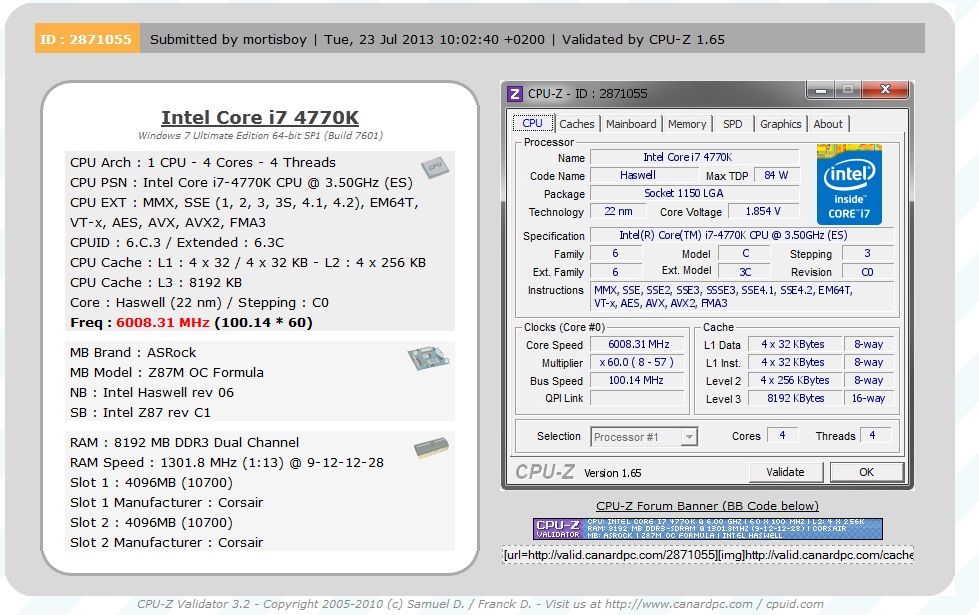 142
142
Intel Haswell i5-4670K vs. i7-4770K Comparison Review
Synthetic Benchmarks »System Setup
| Test System | |
|---|---|
| Processor: | Intel Core i5-4670K (Haswell, 6 MB Cache) Intel Core i7-4770K (Haswell, 8 MB Cache) |
| Motherboard: | Asrock Z87M OC Formula Intel Z87 |
| Graphics Processors: | Evga GTX 580 Classified |
| Memory: | 2x 4096 MB Corsair Platinum PC3-21300 DDR3 @ 2400 MHz 9-11-11-24 |
| Harddisk: | Corsair Neutron 64 GB |
| Cooling methods: | Prolimatech Megahalems EK WC Kit L360 with Supremacy CPU block |
| Power Supply: | Corsair AX 1200i |
| Software: | Windows 7 64-bit Service Pack 1 |
| Drivers: | NVIDIA: 320.18 WHQL |
| Display: | LG Flatron E2260" 1920x1080 |
Here is a photo of the system itself:
Overclocking
Maximizing clock frequency on the new Haswell series is exactly like overclocking an unlocked Ivy-Bridge CPU. However, this time, users have to deal with two additional voltages, vRing, also known as vCache, and vInput, also known as vRIN.vRing is responsible for cache voltage. It will help you overclock cache by changing its multiplier.
vInput sets the voltage the motherboard will supply to the integrated voltage regulator in the CPU. The iVR's purpose is to divide the voltage, supplying different components on the die itself. Some of these components are the cores, cache, and IMC.
For our tests, we overclocked by adjusting the multiplier on both processors. The maximum overlocks we achieved were 4.2 GHz at 1.26 V with the Core i5-4670K, 4.5 GHz at 1.29 V with the retail Core i7-4770K, and 4.7 GHz at 1.23 V with our Core i7-4770K ES.
The variance between overclocking potential from one chip to the next is quite large. I have tested more than four Core i7-4770Ks and only the good ES did 4.7 GHz on air with less than 1.3 V. It's also important to mention that the temperatures are different with the same ambient (room) temperatures and cooling methods. Some chips will produce higher temperatures because of the TIM (between CPU die and IHS) and the iVR.
Let us now take a look at the Core i7-4770K ES's overclocking results, since those are higher than with any other CPU I have tested on the Haswell platform.
Here is the maximum frequency we got on air.

Here is the maximum frequency we achieved with the Core i7-4770K on liquid nitrogen.

As you can see, we achieved a maximum frequency of 6 GHz, which is above average when it comes to Core i7-4770K overclocking. Unfortunately, the CPU cold bugged at -110°C, which means that it cannot operate at temperatures below -110°C.
Jul 15th, 2025 15:54 CDT
change timezone
Latest GPU Drivers
New Forum Posts
- Solidigm NVMe Custom Modded Driver for All NVMe Brands SSDs & Any NVMe SSDs (229)
- Stupid things one has done with hardware (64)
- No offense, here are some things that bother me about your understanding of fans. (143)
- Recommend me a decent budget card :) (33)
- What's your latest tech purchase? (24278)
- TOS 6 on Ugreen NAS (0)
- Folding Pie and Milestones!! (9620)
- TPU's F@H Team (20436)
- Is there a WIFI chip I should get? (4)
- TPU's Nostalgic Hardware Club (20513)
Popular Reviews
- MSI GeForce RTX 5060 Gaming OC Review
- Our Visit to the Hunter Super Computer
- Lexar NM1090 Pro 4 TB Review
- SilverStone SETA H2 Review
- NVIDIA GeForce RTX 5050 8 GB Review
- Fractal Design Epoch RGB TG Review
- Sapphire Radeon RX 9060 XT Pulse OC 16 GB Review - An Excellent Choice
- AMD Ryzen 7 9800X3D Review - The Best Gaming Processor
- Upcoming Hardware Launches 2025 (Updated May 2025)
- Corsair FRAME 5000D RS Review
TPU on YouTube
Controversial News Posts
- Intel's Core Ultra 7 265K and 265KF CPUs Dip Below $250 (288)
- Some Intel Nova Lake CPUs Rumored to Challenge AMD's 3D V-Cache in Desktop Gaming (140)
- AMD Radeon RX 9070 XT Gains 9% Performance at 1440p with Latest Driver, Beats RTX 5070 Ti (131)
- NVIDIA Launches GeForce RTX 5050 for Desktops and Laptops, Starts at $249 (122)
- NVIDIA GeForce RTX 5080 SUPER Could Feature 24 GB Memory, Increased Power Limits (115)
- Microsoft Partners with AMD for Next-gen Xbox Hardware (105)
- Intel "Nova Lake‑S" Series: Seven SKUs, Up to 52 Cores and 150 W TDP (100)
- NVIDIA DLSS Transformer Cuts VRAM Usage by 20% (99)

